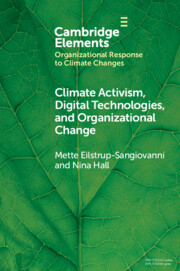42 results
Leadership and overcoming coordination failure with asymmetric costs
-
- Journal:
- Experimental Economics / Volume 10 / Issue 3 / September 2007
- Published online by Cambridge University Press:
- 14 March 2025, pp. 269-284
-
- Article
- Export citation
Barriers to dynamic capabilities in non-leading HEIs in the digital era
-
- Journal:
- Journal of Management & Organization , First View
- Published online by Cambridge University Press:
- 06 February 2025, pp. 1-20
-
- Article
-
- You have access
- HTML
- Export citation

Climate Activism, Digital Technologies, and Organizational Change
-
- Published online:
- 12 December 2024
- Print publication:
- 02 January 2025
-
- Element
- Export citation
Top management team gender diversity and power dynamics in times of change
-
- Journal:
- Journal of Management & Organization , First View
- Published online by Cambridge University Press:
- 23 September 2024, pp. 1-24
-
- Article
-
- You have access
- HTML
- Export citation
2 - What Is Public Sector Innovation?
-
- Book:
- Public Sector Innovation
- Published online:
- 23 November 2024
- Print publication:
- 04 July 2024, pp 10-22
-
- Chapter
- Export citation
How do management factors influence digital adoption in the case of a large-scale digital transformation project – A process perspective
-
- Journal:
- Journal of Management & Organization / Volume 30 / Issue 5 / September 2024
- Published online by Cambridge University Press:
- 06 November 2023, pp. 1564-1584
-
- Article
-
- You have access
- HTML
- Export citation
Chapter 10 - Mindsets for Change Leaders
- from Part IV - The Development of Change Leadership
-
-
- Book:
- The Psychology of Organizational Change
- Published online:
- 28 September 2023
- Print publication:
- 12 October 2023, pp 208-234
-
- Chapter
- Export citation
Chapter 12 - Change Leadership
- from Part V - The Process of Change Leadership
-
-
- Book:
- The Psychology of Organizational Change
- Published online:
- 28 September 2023
- Print publication:
- 12 October 2023, pp 263-288
-
- Chapter
- Export citation
Chapter 3 - The Role of Time in Organizational Change
- from Part II - The Evolution of Change and Its Responses
-
-
- Book:
- The Psychology of Organizational Change
- Published online:
- 28 September 2023
- Print publication:
- 12 October 2023, pp 42-66
-
- Chapter
- Export citation
Public health by organizational fix?
-
- Journal:
- Health Economics, Policy and Law / Volume 18 / Issue 3 / July 2023
- Published online by Cambridge University Press:
- 13 April 2023, pp. 274-288
-
- Article
-
- You have access
- Open access
- HTML
- Export citation

Ambiguity in Organization Theory
- From Intrinsic to Strategic Perspectives
-
- Published online:
- 12 January 2023
- Print publication:
- 02 February 2023
-
- Element
- Export citation
Conclusion
-
- Book:
- The Politics of Religious Party Change
- Published online:
- 22 December 2022
- Print publication:
- 05 January 2023, pp 261-268
-
- Chapter
- Export citation
Déterminants du succès d’une démarche provinciale d’usage optimal des antipsychotiques chez les résidents en soins de longue durée selon les acteurs clés impliqués dans l’implantation
-
- Journal:
- Canadian Journal on Aging / La Revue canadienne du vieillissement / Volume 42 / Issue 1 / March 2023
- Published online by Cambridge University Press:
- 15 August 2022, pp. 102-114
-
- Article
-
- You have access
- HTML
- Export citation
Redefining capabilities as drivers of adaptation, incremental change, and transformation: recognizing the importance of strategic and operational intent on performance
-
- Journal:
- Journal of Management & Organization / Volume 28 / Issue 3 / May 2022
- Published online by Cambridge University Press:
- 06 June 2022, pp. 522-539
-
- Article
- Export citation
Sense and sensibility: How CEOs construct meaning through symbols in organizational change
-
- Journal:
- Journal of Management & Organization , First View
- Published online by Cambridge University Press:
- 07 April 2022, pp. 1-15
-
- Article
- Export citation
5 - Training US Community Mental Health Centers in Evidence-Based Coordinated Specialty Care for First Episode Psychosis
- from Part II - The Present
-
-
- Book:
- Recovering the US Mental Healthcare System
- Published online:
- 03 March 2022
- Print publication:
- 24 February 2022, pp 103-127
-
- Chapter
- Export citation
10 - Recovering US Mental Healthcare
- from Part III - The Future
-
-
- Book:
- Recovering the US Mental Healthcare System
- Published online:
- 03 March 2022
- Print publication:
- 24 February 2022, pp 230-248
-
- Chapter
- Export citation

Cambridge Handbook of Routine Dynamics
-
- Published online:
- 11 December 2021
- Print publication:
- 16 December 2021
10 - Managing Managers in the Multinational Enterprise
- from Part II - Functional Issues
-
- Book:
- International Business Strategy
- Published online:
- 02 September 2021
- Print publication:
- 23 September 2021, pp 249-270
-
- Chapter
- Export citation

Health Care Research and Organization Theory
-
- Published online:
- 18 June 2021
- Print publication:
- 26 August 2021
-
- Element
- Export citation

